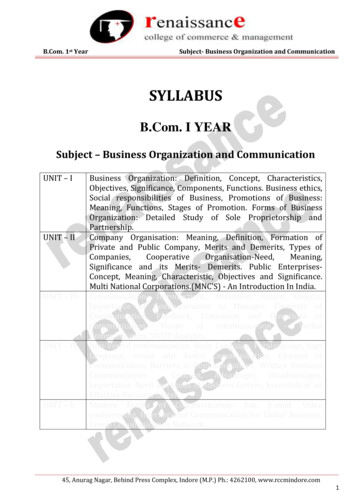
Transcription
B.Com. 1st YearSubject- Business Organization and CommunicationSYLLABUSB.Com. I YEARSubject – Business Organization and CommunicationUNIT – IUNIT – IIUNIT – IIIUNIT – IVUNIT – VBusiness Organization: Definition, Concept, Characteristics,Objectives, Significance, Components, Functions. Business ethics,Social responsibilities of Business, Promotions of Business:Meaning, Functions, Stages of Promotion. Forms of BusinessOrganization: Detailed Study of Sole Proprietorship andPartnership.Company Organisation: Meaning, Definition, Formation ofPrivate and Public Company, Merits and Demerits, Types ignificance and its Merits- Demerits. Public EnterprisesConcept, Meaning, Characteristic, Objectives and Significance.Multi National Corporations.(MNC'S) - An Introduction In India.Communication- Introductions, Definition, Nature, Objects,Importance of Communication to Manager, Elements ofCommunication, Feedback, Dimension and Directions ofCommunication, Means of communication - VerbalCommunication, SWOT Analysis.Non-Verbal communication, Body Language, Paralanguage, SignLanguage, visual and Audio Communication, Channel ofcommunication, Barriers in Communications. Written BusinessCommunication - Concept, Advantages, Disadvantages,Importance. Need and kinds of business Letters, Essentials of anEffective Business Letter.Modern Forms of Communication- Fax, E-mail, Videoconferencing, International Communication for Global Business,Group Communication Network.45, Anurag Nagar, Behind Press Complex, Indore (M.P.) Ph.: 4262100, www.rccmindore.com1
B.Com. 1st YearSubject- Business Organization and CommunicationUNIT – IBusiness –Business implies those activities which are carried on with a view to earn profit/wealth. It is the humanactivity directed towards the acquisition of wealth through the production and exchange of goods andservices.Features or characteristics of business:1)Activity of Human Beings2)Monetary gains3)Exchange of goods & services4)Continuity & regularity5)Creation of utility6)Existence of risk elements7)Organized & systemized institutions8)Entrepreneurship9)Financial Management10) Development of Vasudhaiv Kutumbkam : It implies that whole universe is my family.11) Social commitment12) Consumer is monarch13) It is very comprehensive & wide activity14) A pluralistic institutions: A business organization is a pluralistic institution. Its success is basedon united efforts of various categories of people such as its promoters, investors, employees,government and public.15) Different forms: There are different forms of business organization like sole trading. Partnership,company, departmental organization, corporations, trusts, boards etc.16) An institution with multiple objectives17) Dynamic environment18) Government control and regulation19) An organ of the society20) Innovation and marketing as basic function21) Customer SatisfactionObjectives of Business:Object of Business: The following are the main objects of business:(a) Economics object or profit motto.(b) Social object or service motto.(c) Human object.(d) National object.(a) Economic object or profit motto.(1)For expansion of business(2)Profit is a Reward of Entrepreneur(3)Protection against future risk(4)Basis of investment(5)Barometer of efficiency and success(6)Safeguard of employees economic interest(7)Creation of Goodwill(8)Source of public Revenue(9)For existence of business45, Anurag Nagar, Behind Press Complex, Indore (M.P.) Ph.: 4262100, www.rccmindore.com2
B.Com. 1st YearSubject- Business Organization and Communication(b) Service Motto/Social object1) Each business activity is undertaken keeping in view the interest of consumers because there is noexistence of business without customers.2) The object of business must be maximum satisfaction for the customer.3) The entrepreneur must always accept reasonable price for the article sold by him becausereasonable price policy makes the customer permanent.4) The businessmen must always produce or manufacture and sell articles of a high standard andquality.5) The businessmen must always try to improve the quality his product. This helps the consumer ingetting good services and the future of business remain bright.(c) Human Object:Day-to-day work of the business is done by employee and workers. Thus, to keep in view the satisfactionof all the people connected with the business comes within the purview of human object.(d) National Object:The fourth object of business is national object national object means conduct of business protecting theinterest of the nation, Conduct of business free from hording, profiteering, smuggling comes within thescope of national object.Organization –An organization is a group of people intentionally organized to accomplish an overall, common goal or setof goals.Characteristics of Organization –1) Division of labour2) Coordination3) Accomplishment of common objectives4) Authority responsibility structure5) CommunicationBusiness Organization –Business organization is concerned with the study of the methods and procedures of establishing andoperating business enterprises with the purpose of earning profits by rendering service to the society.The scope is very wide. It comprises business ownership, the types of traders engaged in the supply ofgoods and services, the institutions which facilitate trade, the financial arrangements used to conductbusiness, the problems of location and layout of the undertaking, the principles of management, forms ofcombinations, methods of wage payment, etc.Objectives of Business Organization1) Unity of objectives2) Efficiency3) Division of work4) Span of control5)6)7)8)Scalar principleDelegationFunctional definitionAbsoluteness of responsibilityFunctions of Business Organization –1) Production function2) Marketing function3) Finance function4) Personnel function5) Other functions45, Anurag Nagar, Behind Press Complex, Indore (M.P.) Ph.: 4262100, www.rccmindore.com3
B.Com. 1st YearSubject- Business Organization and CommunicationSignificance of Business Organization –1) Facilitates administration2) Ensures specialization3) Facilitates growth and diversification4) Encourages creativity5) Optimum use of technological improvements6) Facilitates coordination7) Rapid economic developmentComponents of Business Organization –45, Anurag Nagar, Behind Press Complex, Indore (M.P.) Ph.: 4262100, www.rccmindore.com4
B.Com. 1st YearSubject- Business Organization and CommunicationII. CommerceCommerce means those activities which are done from production of commodities and their supply toconsumers with the object of earning profit.Characteristics(i)Trade is included in commerce.(ii)Subsidiary activities of trade like insurance, banking, transportation are also included incommerce.(iii)Commerce is a link between a producer and a consumer.(iv)Commerce creates time and place utility.(v)Commerce removes obstacles arising in exchange of commodities.III. TradePurchase and sale of goods in a business in order to earn profit is called trade. Thus the following are thecharacteristics of trade(i)Purchase and sale of commodities and services.(ii)Two parties- Buyer and sellers. Middleman are also included in it.(iii)The main object of trade is to earn profit.(iv)Medium of trade is money.(v)Element of risk and enterprise exists in trade.(vi)Business activities remain regular and continues.(vii) Purchase of a commodity is meant for sale.Social Responsibility of BusinessSocial responsibility means the objective concern for the welfare of society.“Social responsibility is to pursue those policies and decisions or to follow those lines of actions whichare desirable in terms of the objective and value of our society.”Features:1. Social responsibility is a two-way traffic2. It is related with business organizations3. Universal concept4. Supremacy of public interest5. Scope of social responsibility is not limited6. Establishes new socio-economic values: it establishes new economic and social values such asdecentralization of power, equal and justified distribution of resources, business morality, etc.7. Source of gaining social power8. Basis of business success9. It is a continuous processObjectives:1. Social Welfare2. Satisfaction of human wants and improvement of standard of living.3. Promotion of business4. Creation of positive public image5. Development of nation.Methods of Discharging Social Responsibility1. Adoption of different types of social programs(a) pursuing the goal of economic growth and efficiency by improving productivity and cooperatingwith the government.(b) Helping colleges and universities through grants, donations, funding of research programme,maintenance of interaction, training and placement of students.45, Anurag Nagar, Behind Press Complex, Indore (M.P.) Ph.: 4262100, www.rccmindore.com5
B.Com. 1st YearSubject- Business Organization and Communication(c) Retraining and placement of disadvantaged or retiring workers.(d) Undertaking urban development programmes such as low cost housing, adoption of backwardareas.(e) Pollution and effluent control.(f) Ecological conservation and recreation.(g) Patronizing art and culture through and to institutions engaged in such tasks.(h) Designing low cost medical care programmes.(i) Improving management in government.2. Substituting optimum profits against maximum profits When a company is operating undervoluntarily imposed restraints, it is said to be satisfying rather than maximizing profits.3. Cooperating with various Stockholder4. Prescription of social goals as integral part of the corporate policyCauses for growing concern for social responsibilities1. Public Opinion.2. Trade Union Movement3. Consumerism4. Education5. Public Relation6. Managerial revolution.Scope of social Responsibility:Social responsibility is two-way traffic.I. Social responsibility of business towards different sections of the society.II. Social responsibility of different sections of the society towards the business.I. Social responsibility of business Towards Different Section of the Society:1. Towards the business itself2. Towards the owners of business3. Towards the creditors4. Towards the employees5. Towards the suppliers of goods6. Towards professional institutions7. Towards other business institutions8. Towards local community9. Towards the government10. Towards the world societyII. Social Responsibility of Different Section of Society Towards Business:1. Responsibility of owners2. Responsibility of employees3. Responsibility of consumers4. Responsibility of investors5. Responsibility of suppliers6. Responsibility of professional institution: The professional institution of Management Studies,Chartered Accountants, cost Accountants, etc. should inform the business about the latestprofessional knowledge and techniques developed by them through publications, organizing theseminars and conferences. The business managers may be invited to participate in suchprogrammes.45, Anurag Nagar, Behind Press Complex, Indore (M.P.) Ph.: 4262100, www.rccmindore.com6
B.Com. 1st YearSubject- Business Organization and Communication7. Responsibility of top level managers8. Responsibility of the communitySignificance social responsibility of Business:1. Need to balance power with Responsibility2. Voluntary actions would prevent government regulation3. To promote long-run profits4. Recognition of moral obligations by business5. Vastness of resources and intricate social problems6. Correction of business causing social business7. Creation of positive public image8. Response to changing public expectations.Limitations of Social Responsibility:1. Unsupported by logic2. Militates against the test of market place3. Cost burden on consumers4. Non-availability of social skills5. Correction of ironical situations6. Diversion from the main objective7. Adverse impact on economic efficiencyPROMOTION OF BUSINESSPROMOTION‘Promotion of a business enterprise’ refer to the act and process of establishing a new business unit.Promotion may e defined as the discovery of business opportunities and the subsequent organization offunds, property and managerial ability into a business concern for the purpose of making profitstherefrom.Methods/Stages in Promotion –1) Discovery of Idea2) Investigation and verification3) Assembling4) Financing the propositionPROMOTERThe term ‘Promoter’ stands for a person who conceives the business idea and takes various steps to bringthe enterprise into existence and to grow is as a successful venture.Types of Promoters1. Occasional Promoters: The are those entrepreneurs who promote a business enterprise andmanage its affairs after it comes into being. Promotion is not occupation of such entrepreneurs.2. Professional Promoters: these person are specialists in promoting new business ventures.Promotion is their whole time occupation.3. Financial promotes: their main object is to make use favorable investment climate to earnprofits.4. Technical Promoters: they are expert in technical matters. Areas of their expertise may relate tolaw, engineering, consultants, architects, etc. such promoters are given fee for their consultancyservices.45, Anurag Nagar, Behind Press Complex, Indore (M.P.) Ph.: 4262100, www.rccmindore.com7
B.Com. 1st YearSubject- Business Organization and Communication5. Specialized institutions: These institutions float new business enterprises either at their own orby collaborating with other entrepreneurs. Example of such entrepreneurs are IDBI (IndustrialDevelopment Bank of India), NIDC (National Industrial Development Corporation).6. Government7. Political PromotersFUNCTIONS OF PROMOTERS(A) Procedural functions /1. Risk taking – Risk taking is a primary function of entrepreneur & profit is the reward for it.2. Deducing the profit – The foremost function of promoter is to decide the nature of the project tobe undertaken.3. Size of unit – Determination of the size of the unit is another imp. Area.4. Location – The choice of the area & selection of a specific sight in such area.5. Razing fund – After the selection of the project promoter has to arrange for finance6. Choice of organization –He decides the correct type of organization to be formed.7. Production planning – Promoter makes decision regarding technology, machinery, equipments,plants & another project facilities.8. Earning project9. Project report – The promoter takes responsibilities regarding preparation of project report.10. Tax Planning – Promoter consult tax experts to minimize the tax liabilities on the new venture.(B) Legal FunctionsQualities of Successful Promoter1. Winning Personality with leadership Qualities2. Wide knowledge3. Initiative and Foresight4. Dynamic Outlook5. Adaptability6. Self confidence7. Business ethics and Social responsibility8. Consistent in behavior9. Business connection and Goodwill10. Aptitude for research, analysis and growthFORMULATION OF COMPANYI. PromotionII. Incorporation – Once the promotion process is complete, the enterprise is to be registered as a bodycorporate. For this purpose an application is to be to the Registrar of Companies o the prescribed formaccompanied with the following documents:1. Memorandum of Association2. Article f association3. A list of Directors4. Written consent of the Directors to act in that capacity.5. A Statutory Declaration6. Notice of the registered office of the company7. Copy of the letter in which the name of the company has been approvedIII. Floatation of Capital subscriptionCapital Subscription Involves the following steps:45, Anurag Nagar, Behind Press Complex, Indore (M.P.) Ph.: 4262100, www.rccmindore.com8
B.Com. 1st YearSubject- Business Organization and Communication1. To ensure that the proposed issue of securities complies with the guideline laid down by theSecurities and Exchange Board of India (SEBI).2. To make agreement with the underwrites for underwriting of securities.3. To apply to the stock exchange for listing of securities.4. To appoint bankers, share brokers, managers to the issue of securities.5. To file a copy of the prospectus with the Registrar of Companies.6. To advertise the issue of securities and to issue the prospectus for public subscription.7. To get the application form printed and supplied to the public.8. To receive application along with the applications money through the bankers of the company.9. To make allotment of securities. In case of over subscription the allotment must be made inconsultation with stock exchange concerned.10. To file allotment return with the Registrar of Companies within 30 days fro completion ofallotment.IV. Commencement of BusinessFor this purpose, the company should file with the Registrar of companies the following documents:1. A declaration that a prospectus or a Statement in lieu thereof has be filled with the Registrar.2. A declaration that shares payable in cash have been allotted to the extent of minimumsubscription.3. A declaration that the Directors have taken up their qualification shares and that they have painin cash the application and allotment money on shares held by them in the same proportion asothers.4. A declaration that no money I liable to become refundable to the applicants by person of failure toapply for permission.Forms of Business OrganizationSole ProprietorshipMeaning“The sole proprietorship is that form of business ownership which is owned and controlled lay a singleindividual. He receives all the profits and risks all of the property in the success of failure of theenterprise.”Features of sole proprietorship business:1.Easy formation2.No separate legal entity3.Unlimited liabilities4.Individual risk bearing5.Freedom of operation6.Full Mgt.7.One man control8.ContinuityAdvantages of sole proprietorship1.Easy to form and dissolve2.Direct motivation and incentive3.Quick decision and prompt action4.Economy and elimination of wastage5.Flexibility6.Personal touch7.High Secrecy8.Benefit of inherited goodwill9.Freedom of business45, Anurag Nagar, Behind Press Complex, Indore (M.P.) Ph.: 4262100, www.rccmindore.com9
B.Com. 1st YearSubject- Business Organization and CommunicationDisadvantages of sole proprietorship1.Limited resources2.Limited managerial skill & abilities3.Unlimited liabilities4.Temporary existence5.Limited scope for expansion6.Difficulty of personal contact in widely separated areas7.Monotony and hard work8.Hasty decisionPartnershipDefinition of Partnership:“Partnership is the relation existing between person competent to make contracts who have agreedto carry on a lawful business in common, with a review of private gain”The Indian Partnership Act 1932 defines “Partnership” as the relation between persons who haveagreed to share the profits of a business carried on by all or any of them acting you all”Characteristics of Partnership:1. Formation (two more person)2. Agreements- among partners3. Legal business as per the registration under partnership Act.4. Profit Motive5. Unlimited liability6. Non transferability of share7. Full management and control8. Mutual agency9. Utmost good faith10. Individuality of the partner11. No separate entryAdvantages of Partnership1. Easy formation2. Benefit of greater resources3. Sharing of risks4. Protection of minority interests5. Flexibility6. Balanced judgment7. Personal supervision8. More scope for expansion9. Free from various expenses10. Benefit of personal contracts of partnersDisadvantages of Partnership1. Unlimited liability2. Limited resources3. Non-Transferability of shares4. Instability5. Lack of quick decisions6. Lack of public confidence7. Conflicts8. Lack of secrecy and privacy9. Absence of separate legal status45, Anurag Nagar, Behind Press Complex, Indore (M.P.) Ph.: 4262100, www.rccmindore.com10
B.Com. 1st YearSubject- Business Organization and CommunicationPartnership DeedMeaningThe partnership Deed is a document which embodies the terms and conditions of the partnershipagreement laying down the mutual rights, duties and obligations of partners. The deed is stamped inaccordance with the stamp Act.Contents: The common contents of Partnership Deed are1. Name of the firm2. Name and address of the partners3. Nature of the business4. Capital contributed by each partner5. Proportion of division of profit and losses6. The duties, powers and obligations of the partners7. The mode of maintaining accounts8. Management of business9. Provision regarding retirement and dissolution10. Arbitration in case of dispute among partners11. Whether loans will be accepted form a partner12. The amount salary payable to partners13. The rate of interest payable to partners on their capital14. The amount to be allowed as drawings and the rate of interest on amount withdrawn by them.Different types of Partnership1. Partnership at will: The partnership formed to carry on business without specifying and periodof time is known as partnership at will2. Particular partnership: When a partnership is formed for a fixed period or for a completion of adefinite venture.3. Joint venture: it is organized for a specific enture is a specified period. Member of joint venturedo not enjoy general agency rights are defined. No member can withdraw from joint venturebefore the completion of specific venture.4. Limited Partnership: In this liability of partners is limited except that of one or more partners.Different kinds of partners:1. Active Partner: a partner who is activity engaged in the conduct and management of thebusiness.2. Sleeping or dormant partner: The partner who does not participate in the management of thefirm. They contribute capital ad get share in the profit or loss of the firm.3. Nominal Partner: Nominal partner is a partner who lends his name to the firm without havingany interest in the management and profit of the business.4. Partner in profit only: Such partner is a partner who shares the profits of the business withoutmaking himself responsible for the losses.5. Limited partner: Limited partner is a partner whose liability is limite to the amount he hasinvested in the firm as capital.6. Sub Partner: When a partner enters into a new agreement to share his profits with an outsidessuch an outsider is known as partner.7. Partner by estoppels of holding out: It a person represents to the outside world by wordsspoken or written or by his conduct or by lending his nam, that he is a partner in a certainpartnership fir, such person by estoppels or holding out.Requisites of an ideal partnership:1. Mutual faith and understanding45, Anurag Nagar, Behind Press Complex, Indore (M.P.) Ph.: 4262100, www.rccmindore.com11
B.Com. 1st Year2.3.4.5.6.7.8.Subject- Business Organization and CommunicationCommon approachMinimum number and mutual confidenceSkills and talents of partnersAdequate long term capitalLong durationWritten agreementRegistrationREGISTRATION OF PARTNERSHIPUnder the Partnership Act, it is not compulsory for a firm to be registers, but there are certaindisabilities to an unregistered from which it desirable, even virtually compulsory, that the firm beregistered.Procedure of RegistrationThe statement should contain information relating to the following particulars:(i) The name of the firm(ii) The principle place of business(iii) Name of other places where the firm varies on business(iv) The dates on which various partners joined the firm(v) The names in the full and addresses of the partners and(vi) The duration of the firm.DISSOLUTION OF PARTNERSHIPAccording to section 39 of the Indian Partnership Act. 1932, the dissolution of partnership between allthe partners of a firm is called the dissolution the firm. Section 48 of the partnership act, 1932 lays downthe following procedure for the settlement of accounts between partners after the dissolution of the firm:1. Losses including deficiencies of capital should be made good(a) First of profits(b) Then out of capital(c) If need be out o personal contributed of partner in their profit sharing rations.2. The assets of the firm including any sum contributed by partners to make up deficiencies ofcapital will be applied for setting the debts of the firm, in the following order, subject to anyagreement to the contrary.a) First, in paying of the debts of the firm due to third parties.b) Then in paying to each partner ratably any advance or loans given by him in addition to or apartfrom his capital contribution.c) If any surplus is available after discharging the above liabilities, the capital contributed by thepartner may be returned, if possible, in full or otherwise ratably.d) The surplus, if any, shall be divided among the partner in their profit sharing rations.MODES OF DISSOLUTION(A) DISSOLUTION WITHOUT INTERVENTION OF COURT1. Dissolution by agreement.2. Dissolution by notice.3. Dissolution or the happening of certain contingencies.i.By the expiry of the term of duration of the firm.ii.By the completion of the adventure or task of which the firm was contributed.iii.By the death of a partner.iv.By the adjudication of a partner as insolvent.1. Compulsory dissolution:a) When all the partner except one become insolvent.b) When all the partners become insolvent.45, Anurag Nagar, Behind Press Complex, Indore (M.P.) Ph.: 4262100, www.rccmindore.com12
B.Com. 1st YearSubject- Business Organization and Communicationc) When the business becomes illegal.d) When the number of partners exceeds twenty in case of ordinary business and ten in case ofbanking business.(B) DISSOLUTION BY COURT1. When a partners becomes of unsound mind.2. When a partner suffer from permanent incapacity and become permanently incapable ofperforming his duties as a partner.3. When a partner is guilty of misconduct affecting the business of the rm.4. When a partner commits willful or persistent breaches of agreement.5. When a partner has transferred the whole of the interest in the firm to third party.6. When the business of the firm cannot be carried on except al a loss.7. When the court is satisfied as to grounds which render it just and equitable to dissolve the firm.45, Anurag Nagar, Behind Press Complex, Indore (M.P.) Ph.: 4262100, www.rccmindore.com13
B.Com. 1st YearSubject- Business Organization and CommunicationUNIT-2JOINT STOCK COMPANYDefinition & Meaning: - A company is a voluntary association of persons formal and registered underthe present company act, or under any previous laws. In the eyes f law. It is an artificial person havingseparate entity from its members, with perpetual succession and common seal. The capital of thecompany is divided into transferable shares and shareholders are called members.Characteristics of Company:1. Members/subscribers2. Artificial person3. Separate legal entity4. Perpetual succession5. Common seal6. Limited liability7. Share capital8. Transferable shares9. Separate property10. Capacity to sue & to be sued11. Limited capacity to contract12. Management team13. Existence Independent14. Statutory obligation15. Business or property on the name other than its own16. Registered voluntary association/body corporateI. On the basis o incorporation or Registrationa. Chartered Companies: Most of the early companies were set up through a Royal charter issuedby the state o monarch.b. Statutory Company: A statutory company comes into existence by a special act of the parliamentor legislature of the nation of the state. Its rights, duties, liabilities, powers objects, scope, etc. areclearly defined in the Act, which brings the company into existence.c. Registered Company: Companies which are registered under the provisions of the CompaniesAct of the nation concerned are known as “Registered Companies”.II. On the basis f Liabilitya. Companies with Unlimited Liability: In the case of unlimited liability, a shareholder hasb. to meet the debts of the company even from his private property in the event of winding up of acompany.c. Company with liability limited by guarantee: The liability of members in such a company islimited to a specific amount guaranteed by the members. The purpose of such a guarantee is toenable the company to have funds to meet its liability at the winding up of accompany.45, Anurag Nagar, Behind Press Complex, Indore (M.P.) Ph.: 4262100, www.rccmindore.com14
B.Com. 1st YearSubject- Business Organization and Communicationd. Companies with liability limited by shares: The liability of members in such a company islimited only to the amount of the shares held by them.III. Companies on the basis of Public Interesta. Private Limited Company: A private company is one which, by its Articles: Limits the number of its members to fifty, excluding past and present employees: Restricts the right of the members to transfer the shares; and Prohibits the invitation to public to subscribe to the company’s shares and debenturesb. Public Limited Company: A public company does not limit the number of members to fifty, itdoes not restrict the right of members to transfer their shares and finally it does not prohibitinvitation to public to subscribe to its shares and debentures.c. Government Companies: A government company is one in which at least 51% of the paid upcapital is held by the Central Government or by any State Government or partly by the CentralGovernment and partly by one or more State Government.Advantages of Joint Stock Companya.Large Financial Resourcesb.Limited Liabilityc.Democratic Managementd.Economies of Large Scale Operationse.Statutory Regulationsf.Public Confidenceg.Availability of Expert Servicesh.Research and Developmenti.Tax Concessionj.Bolder Managementk.Contribution to Societyl.Economic Developmentm.Social DesirabilityDisadvantages of Joint Stock Companya.Difficult in Formationb.Bureaucratic Administrationc.Lack of Personal Touchd.Excessive Government Controle.Concentration of Economic Power and Wealthf.Undue or Reckless Speculation in sharesg.Lack of Motivationh.Delay in Policy Decisionsi.Incapable Management and Fraudul
Written Business Communication - Concept, Advantages, Disadvantages, Importance. Need and kinds of business Letters, Essentials of an Effective Business Letter. UNIT - V Modern Forms of Communication- Fax, E-mail, Video conferencing, International Communication for Global Business, Group Communication Network.











